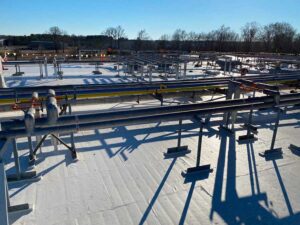
Commercial flat roofing systems are becoming increasingly popular in the Holly Springs area. Designed for commercial buildings, flat roofs offer numerous benefits and advantages. From their key features and materials used in construction to the installation process and maintenance tips, understanding all aspects of commercial flat roofing is essential for property owners and managers. In this article, we will discuss the ins and outs of commercial flat roofing in Holly Springs, providing you with valuable insight to make informed decisions regarding your building’s roofing needs.
Understanding Flat Roofing Systems
Before diving into the details, let’s first take a closer look at flat roofing systems. Unlike pitched roofs commonly seen in residential buildings, flat roofs have a low slope or no slope at all. This design helps optimize space utilization and accessibility, making them ideal for commercial structures.
Key Features of Flat Roofs
Flat roofs are known for their unique features that set them apart from other roofing systems. One of the key characteristics is their ability to provide excellent water drainage. Flat roofs are designed to allow water to flow easily towards the drains, preventing pooling and minimizing the risk of leaks or damage.
Furthermore, flat roofs offer increased stability and durability, making them capable of handling heavy equipment and withstand harsh weather conditions. Their low maintenance requirements and long lifespan are additional advantages for commercial building owners.
Materials Used in Flat Roofing
When it comes to materials used in flat roofing, there are several options available. The choice of material depends on factors such as budget, climate, and desired aesthetics.
One commonly used material is EPDM (Ethylene Propylene Diene Monomer), a synthetic rubber membrane. EPDM is highly durable, resistant to UV rays, and provides excellent waterproofing capabilities.
TPO (Thermoplastic Olefin) is another popular choice for flat roofs. This single-ply roofing material offers remarkable energy efficiency, exceptional strength, and easy installation.
PVC (Polyvinyl Chloride) is a versatile material widely used in flat roofing. PVC roofs are known for their fire resistance, durability, and ability to withstand chemicals and UV exposure.
Choose the right material for your commercial flat roof based on your specific requirements, and consult with a professional to ensure proper installation.
Benefits of Commercial Flat Roofing
Now that we have a solid foundation of knowledge about flat roofing systems, let’s explore the advantages they offer for commercial buildings in Holly Springs.
Energy Efficiency and Sustainability
Flat roofs enable the installation of energy-efficient solutions such as solar panels and green roofs. By harnessing renewable energy and implementing sustainable practices, commercial building owners can reduce their carbon footprint and lower energy costs over time.
Additionally, flat roofs minimize heat transfer, resulting in improved insulation and energy conservation. This not only contributes to environmental sustainability but also helps reduce utility expenses for businesses.
Space Utilization and Accessibility
Flat roofs provide ample usable space that can be utilized for various purposes. From rooftop gardens and outdoor gathering areas to HVAC system installations and satellite dishes, the possibilities are virtually limitless.
Moreover, flat roofs offer easy access for maintenance, repairs, and equipment installations. This accessibility translates into reduced costs and quicker response times when addressing any issues that may arise.
Installation Process of Flat Roofs
When it comes to installing a flat roof for your commercial building in Holly Springs, it’s crucial to follow proper procedures to ensure a successful outcome. Let’s go through the necessary steps.
Pre-Installation Considerations
Prior to the installation, it is important to thoroughly inspect the existing roof and assess its condition. This step helps identify any underlying issues that need to be addressed before installing the new roof. It’s also essential to determine the appropriate insulation and drainage system that suits the specific needs of the building.
Consulting with a reputable flat roofing contractor can provide valuable guidance and recommendations during this preparatory phase, ensuring a smooth installation process.
Step-by-Step Installation Guide
The installation process typically involves the following steps:
- Cleaning and preparing the roof surface: This includes removing any debris, repairing damaged areas, and ensuring a clean and smooth surface.
- Applying the underlayment: A waterproof underlayment is applied to provide an additional layer of protection against water penetration.
- Installing the roofing material: The chosen flat roofing material is installed, ensuring proper alignment and secure attachment.
- Sealing and flashing: All joints, seams, and penetrations are sealed and flashed to prevent water infiltration and enhance overall waterproofing.
- Finishing touches: The final touches, such as adding edge trims and ensuring proper drainage, are completed to ensure the roof functions optimally.
Professional installation is crucial for the longevity and performance of the flat roof. Hiring an experienced flat roofing contractor will ensure the installation is carried out effectively and efficiently.
Maintenance and Repair of Flat Roofs
To maximize the lifespan and performance of a commercial flat roof, regular maintenance and prompt repairs are essential. Here are some important tips to keep in mind.
Regular Inspection and Maintenance Tips
Performing routine inspections is crucial in spotting any potential issues early on. Inspect the roof at least twice a year, particularly after severe weather events, to identify any signs of damage or deterioration. Clear debris, clean gutters and drains, and ensure proper ventilation to prevent mold and mildew growth.
Regular maintenance tasks include resealing joints, repairing punctures or tears, and replacing damaged or worn-out components. By staying proactive and addressing minor problems promptly, you can prevent major issues and extend the lifespan of your flat roof.
Identifying and Addressing Common Issues
Some common issues that may arise with flat roofs include ponding water, leaks, membrane damage, and insulation problems. It’s crucial to identify these issues early and consult with a professional roofing contractor to determine the best course of action.
Contracting a specialized flat roofing company for repairs ensures the use of appropriate materials and techniques, resulting in effective and long-lasting solutions.
Choosing a Flat Roofing Contractor in Holly Springs
Now that you are well-informed about commercial flat roofing, it’s time to find a reliable contractor to handle your installation, maintenance, and repair needs. Here are some qualities to look for in a flat roofing contractor:
Qualities to Look for in a Contractor
- Experience: Choose a contractor with extensive experience in commercial flat roofing projects.
- Expertise: Ensure that the contractor specializes in flat roofing systems and has in-depth knowledge of the latest techniques and materials.
- Reputation: Check the contractor’s reviews, testimonials, and portfolio to assess their reputation and credibility.
- Licensing and Insurance: Verify that the contractor is properly licensed and carries appropriate insurance coverage.
- Customer Service: Opt for a contractor known for their professionalism, responsiveness, and commitment to customer satisfaction.
Questions to Ask Your Potential Contractor
When evaluating potential flat roofing contractors, ask them the following questions:
- How long have you been installing flat roofs in Holly Springs?
- Can you provide references from previous clients?
- What type of warranty do you offer for your work?
- Will you handle obtaining necessary permits for the project?
- What are your safety protocols and practices?
By asking these questions and thoroughly researching your options, you can select a flat roofing contractor that meets your specific requirements and ensures a successful roofing project.
In conclusion, Holly Springs commercial flat roofing offers numerous benefits, including energy efficiency, space utilization, and easy access for maintenance. By understanding the key features, materials used, and proper installation and maintenance processes, commercial building owners can make informed decisions and take the necessary steps to protect and enhance their roofing investments. Hiring a reputable flat roofing contractor in Holly Springs is paramount to ensure excellent craftsmanship and long-term performance. With proper care and regular maintenance, your commercial flat roof will reliably serve your building for years to come.
Ready to ensure your Holly Springs commercial property has the top-tier protection it deserves? Look no further than Commercial Roofing Rana, your Platinum-level Duro-Last installer. With our extensive experience serving a diverse range of commercial buildings across the Mid-South, we’re equipped to deliver the superior quality and service your commercial roof requires. Don’t let the next rainstorm catch you unprepared. Protect your employees, customers, and inventory with a roofing system that’s inspected for quality and designed for perfection. Schedule Now and join the ranks of satisfied business owners who trust Commercial Roofing Rana for their roofing needs.
